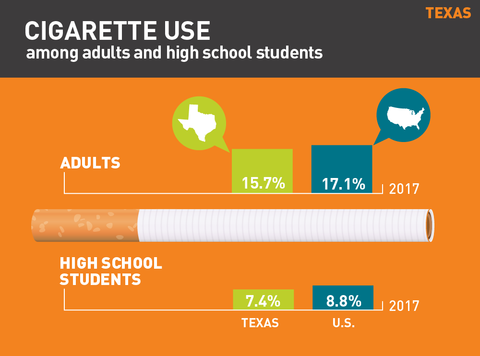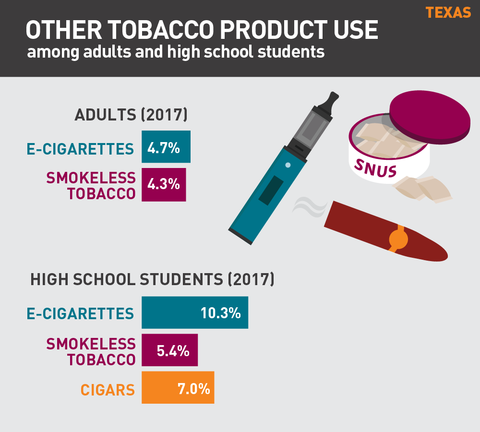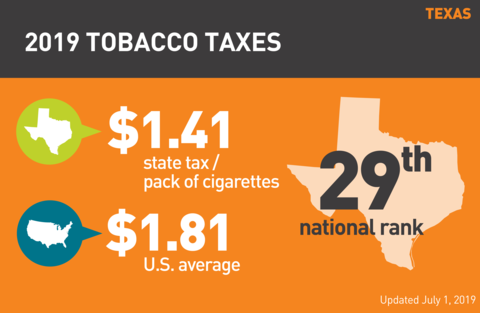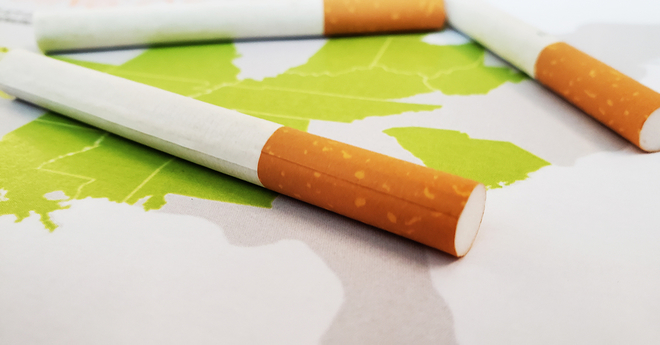Tobacco use in Texas 2019
Cigarette use: Texas
Cigarette use in Texas
- In 2017, 15.7% of adults smoked. Nationally, the rate was 17.1%.1
- In 2017, 7.4% of high school students in Texas smoked cigarettes on at least one day in the past 30 days. Nationally, the rate was 8.8%.2
Other tobacco product use: Texas
E-cigarette and smokeless tobacco use in Texas
- In 2017, 4.7% of adults in Texas used e-cigarettes and 4.3% used smokeless tobacco.3
- In 2017, 10.3% of high school students in Texas used electronic vapor products on at least one day in the past 30 days. Nationally, the rate was 13.2%.2
- In 2017, 5.4% of high school students in Texas used chewing tobacco, snuff or dip on at least one day in the past 30 days. Nationally, the rate was 5.5%.2
- In 2017, 7.0% of high school students in Texas smoked cigars, cigarillos or little cigars on at least one day in the past 30 days. Nationally, the rate was 8.0%.2
Economics of tobacco use and tobacco control
Economics of tobacco use in Texas
- Texas received $1.9 billion (estimated) in revenue from tobacco settlement payments and taxes in fiscal year 2019.4
- Of this, the state allocated $4.2 million in state funds to tobacco prevention in fiscal year 2019, 1.6% of the Centers for Disease Control and Prevention’s annual spending target.4
- Smoking-caused health care costs: $8.85 billion per year.4
- Smoking-caused losses in productivity: $8.22 billion per year.5
Texas tobacco laws
Cigarette tax in Texas
Tobacco taxes
- Texas is ranked 29th in the U.S. for its cigarette tax of $1.41 per pack (enacted January 2007), compared to the national average of $1.81. (The District of Columbia has the highest tax at $4.50 and Missouri has the lowest at 17 cents.)6-8
- Cigars are taxed 1 cent per 10 (or fraction of 10 for those weighing less than three pounds per thousand). Cigars weighing more than three pounds per thousand are taxed at $7.50-$15 per thousand, depending on their factory list price and whether they contain a substantial amount of non-tobacco ingredients. All other tobacco products are taxed $1.22 per ounce.6,7
Clean indoor air ordinances
- Smoking is prohibited in childcare facilities.6,7
- Smoking restrictions are required in schools and recreational/cultural facilities.6,7
- There are no smoking restrictions for government workplaces, private workplaces, restaurants, bars, casinos/gaming establishments and retail stores.6,7
- Many municipalities in Texas have local 100% smoke-free laws, to include bars.
- The use of e-cigarettes is prohibited in schools, at before/after-school programs, inside state Department of Criminal Justice facilities, at childcare homes and centers, in residential child care facilities and in vehicles transporting children, in licensed pediatric extended care transportation vehicles, and in foster homes or when transporting foster children by car.9
Youth access laws
- The minimum age to purchase tobacco products in Texas is 21. In December 2019, the United States adopted a law raising the federal minimum age of sale of all tobacco products to 21, effective immediately.
- Minors are prohibited from buying alternative nicotine products, including e-cigarettes.6
- Establishments are required to post signs stating that sales to minors are prohibited.6
Local tobacco laws
- Kirby, Leon Valley and San Antonio have banned the sale of tobacco products to those under 21.10
Quitting statistics and benefits
Quitting statistics in Texas
- The CDC estimates 57.4% of daily adult smokers in Texas quit smoking for one or more days in 2017.3
- In 2014, the Affordable Care Act required that Medicaid programs cover all tobacco cessation medications.7**
- Texas’s state quit line invests 60 cents per smoker, compared to the national average of $2.21.7
- Texas does not have a private insurance mandate provision for cessation.7
Notes and references
Updated April 2019
*National and state-level prevalence numbers reflect the most recent data available. This may differ across state fact sheets.
**The seven recommended cessation medications are NRT gum, NRT patch, NRT nasal spray, NRT inhaler, NRT lozenge, Varenicline (Chantix) and Bupropion (Zyban).
Fiore MC, et al. Treating Tobacco Use and Dependence: 2008 Update. Clinical Practice Guideline. Rockville, MD: US Department of Health and Human Services. Public Health Service: May 2008.
1. CDC, Behavioral Risk Factor Surveillance System, 2017.
2. CDC, Youth Risk Behavior Surveillance System, 2017.
3. CDC, Behavioral Risk Factor Surveillance System, State Tobacco Activities Tracking and Evaluation System, 2017.
4. Campaign for Tobacco-Free Kids, Broken Promises to Our Children: a State-by-State Look at the 1998 State Tobacco Settlement 20 Years Later FY2019, 2018.
5. Campaign for Tobacco-Free Kids, Toll of Tobacco in the United States.
6. American Lung Association, State Legislated Actions on Tobacco Issues (SLATI).
7. American Lung Association, State of Tobacco Control, 2019.
8. Campaign for Tobacco-Free Kids. State Cigarette Excise Tax Rates & Rankings. https://www.tobaccofreekids.org/assets/factsheets/0097.pdf.
9. Public Health Law Center. U.S. E-Cigarette Regulation: 50-State Review. http://www.publichealthlawcenter.org/resources/us-e-cigarette-regulations-50-state-review.
10. Campaign for Tobacco-Free Kids. States and Localities that have Raised the Minimum Legal Sales Age for Tobacco Products to 21. https://www.tobaccofreekids.org/assets/content/what_we_do/state_local_issues/sales_21/states_localities_MLSA_21.pdf.




